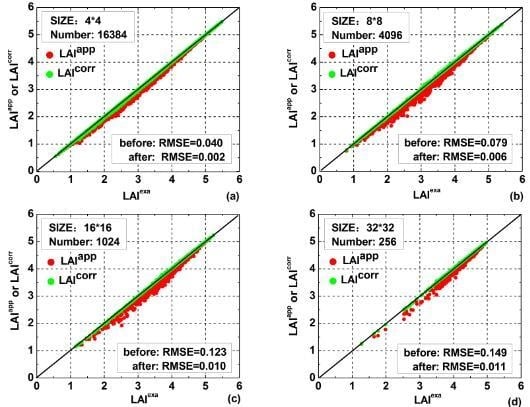Spatial Up-Scaling Correction for Leaf Area Index Based on the Fractal Theory
Abstract
:1. Introduction
2. Materials and Methods
2.1. Materials
2.2. Methods
3. Results and Analysis
3.1. Calculation of Information Fractal Dimension
3.2. Correction of Scaling Effect
3.3. Analysis of Correction Error
3.4. Validation of LAI Scaling Transfer Method
4. Discussion
5. Conclusions
Acknowledgments
Author Contributions
Conflicts of Interest
References
- Hilker, T.; Hall, F.G.; Coops, N.C.; Lyapustin, A.; Wang, Y.J.; Nesic, Z.; Grant, N.; Black, T.A.; Wulder, M.A.; Kljun, N.; et al. Remote sensing of photosynthetic light-use efficiency across two forested biomes: Spatial scaling. Remote Sens. Environ. 2010, 114, 2863–2874. [Google Scholar] [CrossRef]
- Nagler, P.L.; Brown, T.; Hultine, K.R.; van Riper, C.; Bean, D.W.; Dennison, P.E.; Murray, R.S.; Glenn, E.P. Regional scale impacts of Tamarix leaf beetles (Diorhabda carinulata) on the water availability of western US rivers as determined by multi-scale remote sensing methods. Remote Sens. Environ. 2012, 118, 227–240. [Google Scholar] [CrossRef]
- Raptis, V.S.; Vaughan, R.A.; Wright, G.G. The effect of scaling on land cover classification from satellite data. Comput. Geosci.-UK 2003, 29, 705–714. [Google Scholar] [CrossRef]
- Chini, M.; Chiancone, A.; Stramondo, S. Scale Object Selection (SOS) through a hierarchical segmentation by a multi-spectral per-pixel classification. Pattern Recogn. Lett. 2014, 49, 214–223. [Google Scholar] [CrossRef]
- Huang, J.X.; Tian, L.Y.; Liang, S.L.; Ma, H.Y.; Becker-Reshef, I.; Huang, Y.B.; Su, W.; Zhang, X.D.; Zhu, D.H.; Wu, W.B. Improving winter wheat yield estimation by assimilation of the leaf area index from Landsat TM and MODIS data into the WOFOST model. Agric. For. Meteorol. 2015, 204, 106–121. [Google Scholar] [CrossRef]
- Huang, J.X.; Fernando, S.; Huang, Y.B.; Ma, H.Y.; Li, X.L.; Liang, S.L.; Tian, L.Y.; Zhang, X.D.; Fan, J.L.; Wu, W.B. Assimilating a synthetic Kalman filter leaf area index series into the WOFOST model to improve regional winter wheat yield estimation. Agric. For. Meteorol. 2016, 216, 188–202. [Google Scholar] [CrossRef]
- Zhang, R.H.; Tian, J.; Li, Z.L.; Su, H.B.; Chen, S.H.; Tang, X.Z. Principles and methods for the validation of quantitative remote sensing products. Sci. China Ser. D 2010, 53, 741–751. [Google Scholar] [CrossRef]
- Liang, L.; Schwartz, M.D.; Fei, S.L. Validating satellite phenology through intensive ground observation and landscape scaling in a mixed seasonal forest. Remote Sens. Environ. 2011, 115, 143–157. [Google Scholar] [CrossRef]
- Zhang, H.; Jiao, Z.T.; Yang, H.; Li, X.W.; Wang, J.D.; Su, L.H.; Yan, G.J.; Zhao, H.G. Research on scale effect of histogram. Sci. China Ser. D 2002, 45, 949–961. [Google Scholar] [CrossRef]
- Sellers, P.J.; Dickinson, R.E.; Randall, D.A.; Betts, A.K.; Hall, F.G.; Berry, J.A.; Collatz, G.J.; Denning, A.S.; Mooney, H.A.; Nobre, C.A.; et al. Modeling the exchanges of energy, water, and carbon between continents and the atmosphere. Science 1997, 275, 502–509. [Google Scholar] [CrossRef] [PubMed]
- Arora, V. Modeling vegetation as a dynamic component in soil-vegetation-atmosphere transfer schemes and hydrological models. Rev. Geophys. 2002, 40, 1–26. [Google Scholar] [CrossRef]
- Jonathan, A. Vegetation-Climate Interaction; Springer-Verlag: London, UK, 2010. [Google Scholar]
- Che, M.L.; Chen, B.Z.; Zhang, H.F.; Fang, S.F.; Xu, G.; Lin, X.F.; Wang, Y.C. A new equation for deriving vegetation phenophase from time series of leaf area index (LAI) data. Remote Sens. 2014, 6, 5650–5670. [Google Scholar] [CrossRef]
- Friedl, M.A.; Davis, F.W.; Michaelsen, J.; Moritz, M.A. Scaling and uncertainty in the relationship between the NDVI and land surface biophysical variables: An analysis using a scene simulation model and data from FIFE. Remote Sens. Environ. 1995, 54, 233–246. [Google Scholar] [CrossRef]
- Liang, S.L. Numerical experiments on the spatial scaling of land surface albedo and leaf area index. Remote Sen. Rev. 2000, 19, 225–242. [Google Scholar] [CrossRef]
- Tian, Y.H.; Woodcock, C.E.; Wang, Y.J.; Privette, J.L.; Shabanov, N.V.; Zhou, L.M.; Zhang, Y.; Buermann, W.; Dong, J.R.; Veikkanen, B.; et al. Multiscale analysis and validation of the MODIS LAI product: I. Uncertainty assessment. Remote Sens. Environ. 2002, 83, 414–430. [Google Scholar] [CrossRef]
- Chen, J.; Ni, S.X.; Li, J.J.; Wu, T. Scaling effect and spatial variability in retrieval of vegetation LAI from remotely sensed data. Acta Ecol. Sin. 2006, 26, 1502–1508. [Google Scholar]
- Zhu, X.H.; Feng, X.M.; Zhao, Y.S.; Song, X.N. Scale effect and error analysis of crop LAI inversion. J. Remote Sens. 2010, 14, 586–592. [Google Scholar]
- Artan, G.A.; Neale, C.M.U.; Tarboton, D.G. Characteristic length scale of input data in distributed models: implications for modeling grid size. J. Hydrol. 2000, 227, 128–139. [Google Scholar] [CrossRef]
- Fernandes, R.A.; Miller, J.R.; Chen, J.M.; Rubinstein, I.G. Evaluating image-based estimates of leaf area index in boreal conifer stands over a range of scales using high-resolution CASI imagery. Remote Sens. Environ. 2004, 89, 200–216. [Google Scholar] [CrossRef]
- Tian, Q.J.; Jin, Z.Y. Research on calculation and spatial scaling of forest leaf area index from remote sensing image. Remote Sen. Inform. 2006, 4, 5–11. [Google Scholar]
- Jin, Z.; Tian, Q.; Chen, J.M.; Chen, M. Spatial scaling between leaf area index maps of different resolution. J. Environ. Manage. 2007, 85, 628–637. [Google Scholar] [CrossRef] [PubMed]
- Liu, Y.; Wang, J.D.; Zhou, H.M.; Xue, H.Z. Upscaling approach for validation of LAI products derived from remote sensing observation. J. Remote Sens. 2014, 18, 1189–1198. [Google Scholar]
- Hu, Z.; Islam, S. A framework for analyzing and designing scale invariant remote sensing algorithms. IEEE Trans. Geosci. Remote Sens. 1997, 35, 747–755. [Google Scholar]
- Garrigues, S.; Allard, D.; Baret, F.; Weiss, M. Influence of landscape spatial heterogeneity on the non-linear estimation of leaf area index from moderate spatial resolution remote sensing data. Remote Sens. Environ. 2006, 105, 286–298. [Google Scholar] [CrossRef]
- Raffy, M. Change of scale in models of remote sensing: a general method for spatialization of models. Remote Sens. Environ. 1992, 40, 101–112. [Google Scholar] [CrossRef]
- Chen, J.M. Spatial scaling of a remotely sensed surface parameter by contexture. Remote Sens. Environ. 1999, 69, 30–42. [Google Scholar] [CrossRef]
- Xu, X.R.; Fan, W.J.; Tao, X. The spatial scaling effect of continuous canopy leaves area index retrieved by remote sensing. Sci. China Ser. D 2009, 52, 393–401. [Google Scholar] [CrossRef]
- Kim, G.; Barros, A.P. Downscaling of remotely sensed soil moisture with a modified fractal interpolation method using contraction mapping and ancillary data. Remote Sens. Environ. 2002, 83, 400–413. [Google Scholar] [CrossRef]
- Chen, Y.; Chen, L. Fractal Geometry; Earthquake Press: Beijing, China, 2005. [Google Scholar]
- Luan, H.J.; Tian, Q.J.; Yu, T.; Hu, X.L.; Huang, Y.; Du, L.T.; Zhao, L.M.; Wei, X.; Han, J.; Zhang, Z.W.; et al. Modeling continuous scaling of NDVI based on fractal theory. Spectrosc. Spect. Anal. 2013, 33, 1857–1862. [Google Scholar]
- Li, X.W.; Wang, J.D.; Strahler, A.H. Scale effect of Planck’s law over nonisothermal blackbody surface. Sci. China Ser. E 1999, 42, 652–656. [Google Scholar] [CrossRef]
- Su, L.H.; Li, X.W.; Huang, Y.X. An review on scale in remote sensing. Adv. Earth Sci. 2001, 16, 544–548. [Google Scholar]
- Xu, X.R. Physical Principles of Remote Sensing; Peking University Press: Beijing, China, 2005. [Google Scholar]
- Liu, C.H. Remote Sensing Inversion of Crop Leaf Area Index Spatial Scale Transformation Modeling Study. Master’s Thesis, China University of Geosciences (Beijing), Beijing, China, 2013. [Google Scholar]
- Jiang, J.L.; Liu, X.N.; Liu, C.H.; Wu, L.; Xia, X.P.; Liu, M.L.; Du, Z.H. Analyzing the spatial scaling bias of rice leaf area index from Hyperspectral data using wavelet-fractal technique. IEEE J. Sel. Top. Appl. Remote Sens. 2014, 8, 3068–3080. [Google Scholar] [CrossRef]
- Wu, L.; Liu, X.N.; Zheng, X.P.; Qin, Q.M.; Ren, H.Z.; Sun, Y.J. Spatial scaling transformation modeling based on fractal theory for the leaf area index retrieved from remote sensing imagery. J. Appl. Remote Sens. 2015, 9, 096015. [Google Scholar] [CrossRef]
- Rouse, J.W.; Haas, R.H.; Schell, J.A.; Deering, D.W. Monitoring vegetation systems in the Great Plains with ERTS-1. In Proceeding of the Third Earth Resources Technology Satellite Symposium, Washington, DC, USA, 10–14 December 1973; pp. 309–317.
- Mandelbrot, B. How long is the coast of Britain. Science 1967, 156, 636–638. [Google Scholar] [CrossRef] [PubMed]
- Penland, A.R.; Picard, W.; Sclaroff, S. Photobook: Content based manipulation of image databases. Int. J. Comput. Vis. 1996, 18, 233–254. [Google Scholar] [CrossRef]
- Mandelbrot, B. The Fractal Geometry of Nature; Freeman: San Francisco, CA, USA, 1982. [Google Scholar]
- Chen, S.S.; Keller, J.M.; Crownover, R.M. On the calculation of fractal features from images. IEEE Trans. Pattern Anal. 1993, 15, 1087–1090. [Google Scholar] [CrossRef]
- Fan, W.J.; Gai, Y.Y.; Xu, X.R.; Yan, B.Y. The spatial scaling effect of the discrete-canopy 1 effective leaf area index retrieved by remote sensing. Sci. China Ser. D 2013, 56, 1548–1554. [Google Scholar] [CrossRef]
- Jiang, Z.Y.; Huete, A.R.; Chen, J.; Chen, Y.H.; Li, J.; Yan, G.J.; Zhang, X.Y. Analysis of NDVI and scaled difference vegetation index retrievals of vegetation fraction. Remote Sens. Environ. 2006, 101, 366–378. [Google Scholar] [CrossRef]
- Obata, K.; Wada, T.; Miura, T.; Yoshioka, H. Scaling effect of area-averaged NDVI: Monotonicity along the spatial resolution. Remote Sens. 2012, 4, 160–179. [Google Scholar] [CrossRef]
- Liu, L.Y. Simulation and correction of spatial scaling effects for leaf area index. J. Remote Sens. 2014, 18, 1158–1168. [Google Scholar]
- Yu, Z.F.; Lin, Z.J. arithmetic research of fractal dimension with image face based on fractional Brownian motion. Geomat. Inf. Sci. Wuhan Univ. 2005, 30, 161–165. [Google Scholar]
- Chaudhuri, B.B.; Sarkar, N. Texture segmentation using fractal dimension. IEEE Trans. Pattern Anal. 1995, 17, 72–77. [Google Scholar] [CrossRef]
- Jaggi, S.; Quattrochi, D.A.; Lam, N.S.N. Implementation and operation of 3 fractal measurement algorithms for analysis of remote-sensing data. Comput. Geosci.-UK 1993, 19, 745–767. [Google Scholar] [CrossRef]
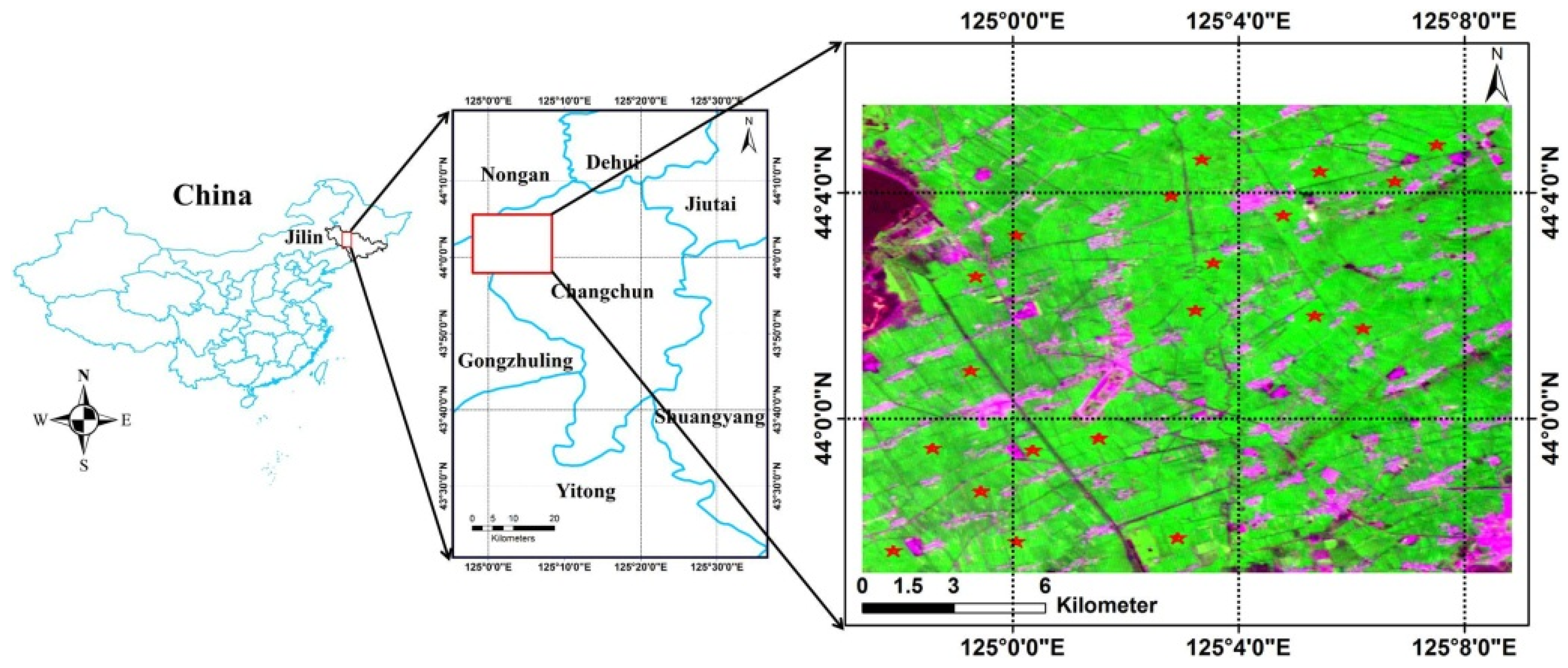




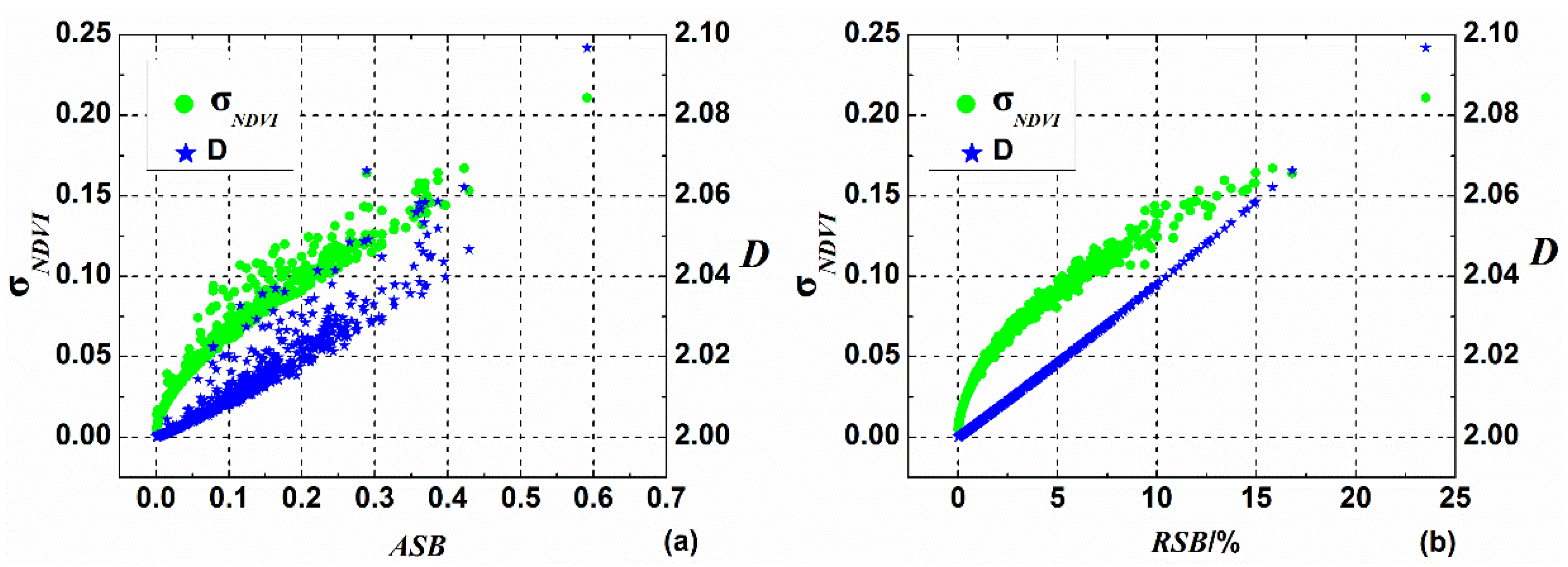
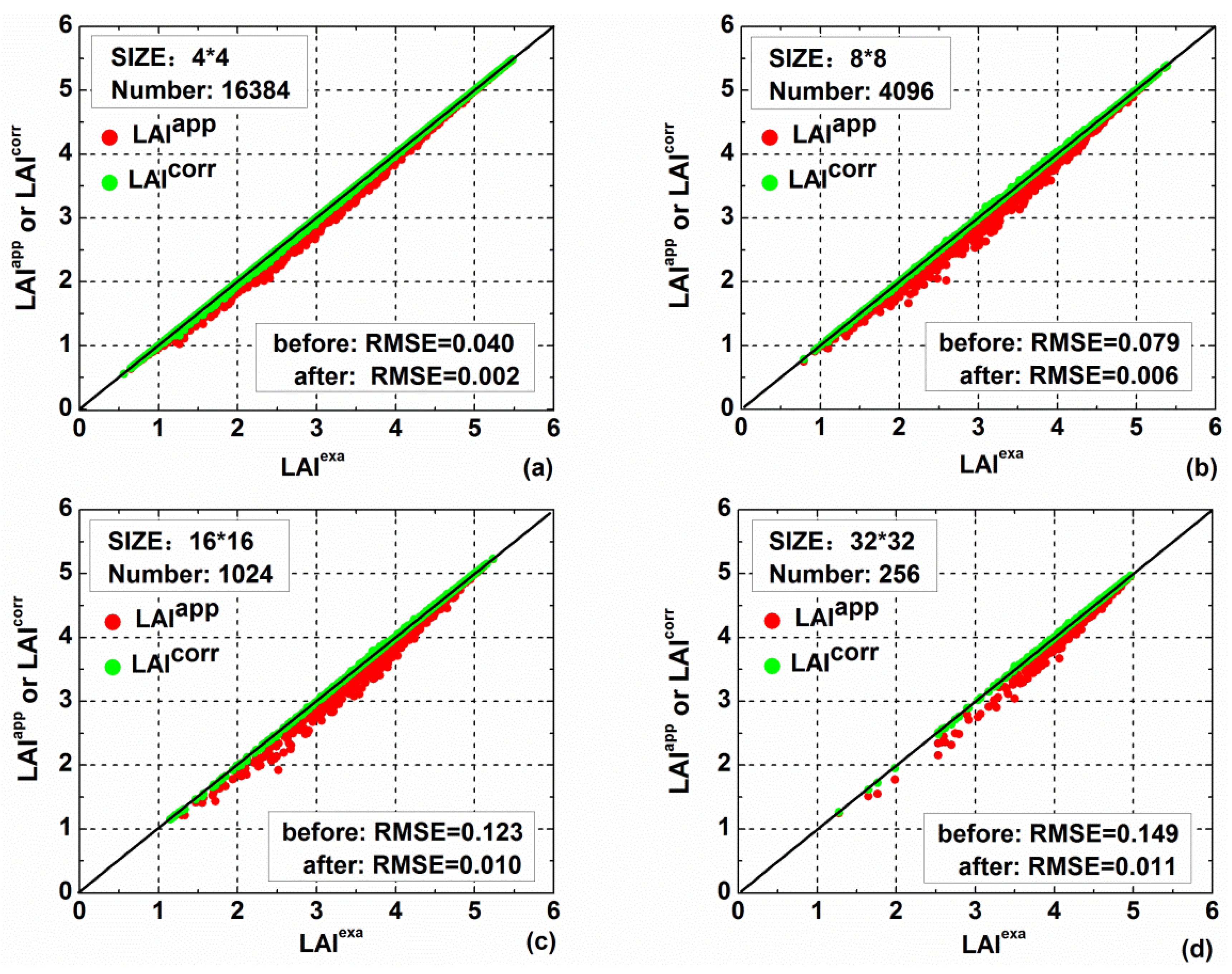

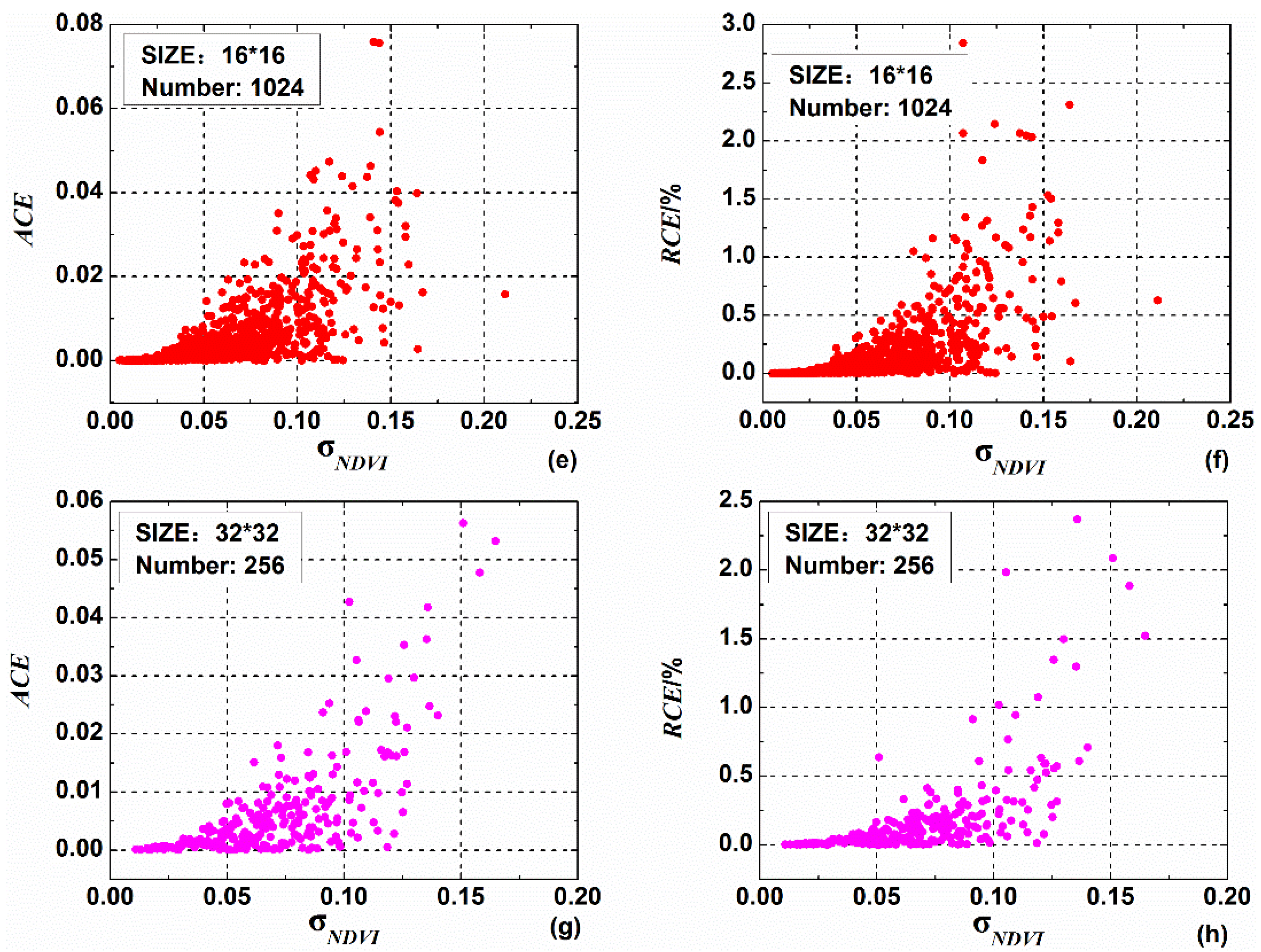
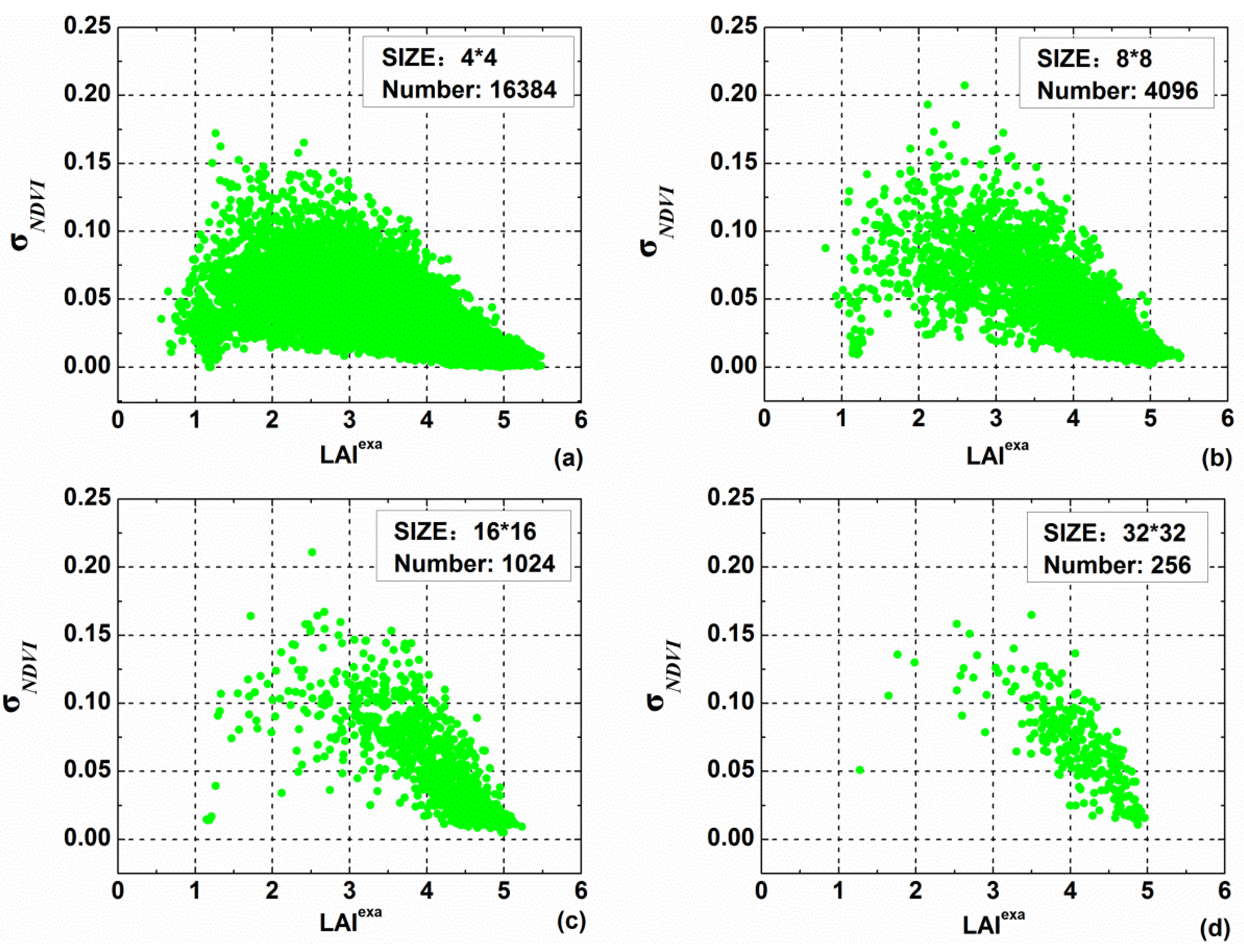

| Scale/Pixels | Before Correction | After Correction | ||||||
| Maximum ASB | Corresponding LAIexa | Maximum RSB/% | Corresponding LAIexa | Maximum ACE | Corresponding LAIexa | Maximum RCE/% | Corresponding LAIexa | |
| 4 × 4 | 0.353 | 2.407 | 19.35 | 1.265 | 0.108 | 1.265 | 8.56 | 1.265 |
| 8 × 8 | 0.576 | 2.595 | 22.21 | 2.595 | 0.082 | 3.094 | 3.15 | 1.098 |
| 16 × 16 | 0.591 | 2.514 | 23.52 | 2.514 | 0.076 | 3.709 | 2.84 | 1.554 |
| 32 × 32 | 0.454 | 3.499 | 14.88 | 2.533 | 0.056 | 2.695 | 2.37 | 1.763 |
© 2016 by the authors; licensee MDPI, Basel, Switzerland. This article is an open access article distributed under the terms and conditions of the Creative Commons by Attribution (CC-BY) license (http://creativecommons.org/licenses/by/4.0/).
Share and Cite
Wu, L.; Qin, Q.; Liu, X.; Ren, H.; Wang, J.; Zheng, X.; Ye, X.; Sun, Y. Spatial Up-Scaling Correction for Leaf Area Index Based on the Fractal Theory. Remote Sens. 2016, 8, 197. https://doi.org/10.3390/rs8030197
Wu L, Qin Q, Liu X, Ren H, Wang J, Zheng X, Ye X, Sun Y. Spatial Up-Scaling Correction for Leaf Area Index Based on the Fractal Theory. Remote Sensing. 2016; 8(3):197. https://doi.org/10.3390/rs8030197
Chicago/Turabian StyleWu, Ling, Qiming Qin, Xiangnan Liu, Huazhong Ren, Jianhua Wang, Xiaopo Zheng, Xin Ye, and Yuejun Sun. 2016. "Spatial Up-Scaling Correction for Leaf Area Index Based on the Fractal Theory" Remote Sensing 8, no. 3: 197. https://doi.org/10.3390/rs8030197
APA StyleWu, L., Qin, Q., Liu, X., Ren, H., Wang, J., Zheng, X., Ye, X., & Sun, Y. (2016). Spatial Up-Scaling Correction for Leaf Area Index Based on the Fractal Theory. Remote Sensing, 8(3), 197. https://doi.org/10.3390/rs8030197






